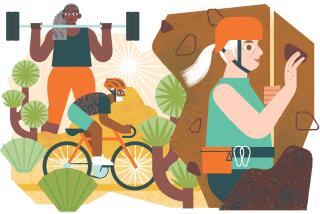Seniors Do the Heavy Lifting to Stay Independent
- Share via
In the quiet of her Pasadena apartment, 89-year-old Irma Roth does something three times a week that surprises her and strangers alike: She exercises.
She begins her 25-minute routine by rotating her ankles, then works her way up, squeezing a burgundy-colored rubber ball between her knees and using a water-filled dumbbell to do biceps curls.
Although she played tennis and roller-skated in her youth, she admits she has never been an “exercise person.”
“The fact that I’m doing it so easily is rather astounding,” said Roth, who started working out at home early last month. “You’d think I’d be sore, but I’m not. Yet I think I’m getting something out of it.”
Roth began exercising because of Healthy Moves, a pilot program offered through four senior service agencies in Southern California. Agency social workers recommended 80 participants -- low-income frail seniors at risk of losing the ability to care for themselves and who don’t have access to a gym.
Organizers said they aren’t trying to turn anyone into an Ernie Van Leeuwen, who at 90 completed the Los Angeles Marathon last March. They simply want to see participants improve their balance, flexibility and strength so they can avoid or delay having to move to a nursing facility.
“We know from research that the one thing you can do for your health at any age is exercise,” said W. June Simmons, president and chief executive of Burbank-based Partners in Care Foundation, a nonprofit that coordinated the program with funding from the John A. Hartford Foundation, a New York-based philanthropy. Through exercise, Simmons said, “people can lower their blood pressure, reduce physical pain, prevent falls and lift depression.... You can’t restore bone, but you can restore muscle.”
Many of the exercises, developed by medical provider PacifiCare, correlate with everyday living. For example, participants might practice standing up from a seated position with their arms crossed over their chests. This develops upper leg muscle strength, needed for such movements as getting out of a chair, bed or car without assistance. Bending down to touch the floor while sitting in a chair works on the flexibility needed to trim toenails. Walking around the house or even in place helps build and maintain stamina and balance.
Despite the benefits of physical activity, there can be obstacles for people who want to become more active, such as not knowing the proper exercises, lacking equipment or maintaining the discipline to exercise regularly.
At a group meeting, Healthy Moves participants are taught how to do the exercises at home. Equipment is minimal: A ball and some dumbbells are enough to get started.
“We took the program to the people who can’t get regular exercise -- people who are isolated, can’t afford a treadmill in the home, can’t drive or get on the bus,” said Simmons.
To overcome the discipline challenge, the program has volunteer “coaches” who regularly call participants. They take note of what exercises were done and whether any discomfort resulted. They also lend an ear.
“We talk about which exercises they like best, which ones are hard, which ones are easy,” said volunteer coach Jessie Lozano, who is 80 herself. “I also ask them how they are doing, if they are getting out and going to church or the movies. I build a rapport with them. I cheer them up. All five of the people I call are happy to hear from me.”
Anwar Zoueihid, lead supervisor of the program offered through City of Commerce-based AltaMed Health Services Corp., said participants “are thrilled about staying physically active. They have more muscle strength, increased energy and a better sense of well-being.”
He even saw an improvement in his diabetic father’s blood-sugar levels and weight after he began exercising as part of the program.
“It has helped me both mentally and physically, and I’m only getting better every day,” said Hani Zoueihid, 69, a retired Monterey Park businessman who is now doing more advanced exercises on equipment that his son purchased. “I’ve noticed I’m not getting sick as often and I’m mentally more alert.”
With those 85 or older being the fastest-growing group of seniors, there is a need to educate the public about the benefits of exercising at any age, said Dr. Richard Brunader, co-director of the new Geriatric Falls Evaluation and Management Clinic at UC Davis.
“Elderly people do respond to physical activity,” he said. “You’re never too old.”
Now that the pilot exercise program is winding down after a year, organizers hope what they have learned from the 80 participants will ultimately help thousands of seniors.
“It was very valuable, and the seniors loved it,” said Simmons. “The part they loved the best was that someone actually thought they could do something to improve their health.”
At training sessions beginning this month, 250 publicly funded social workers in Los Angeles County will be shown eight equipment-free exercises geared to the elderly. As a start, social workers will focus on teaching their older clients just three exercises in an effort to prevent falls. Clients will receive written materials, available in English and Spanish.
“The social workers will try to inspire them. It’s a friendly message, a message of hope,” said Simmons. “This can have a powerful effect.”


